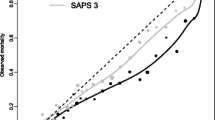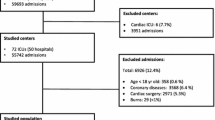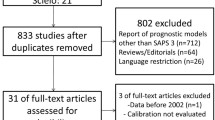Abstract
Objectives
To validate the SAPS 3 admission score in an independent general intensive care case mix and to compare its performances with the APACHE II and the SAPS II scores.
Design
Cohort observational study.
Setting
A 26-bed general ICU from a Tertiary University Hospital.
Patients and participants
Eight hundred and fifty-one consecutive patients admitted to the ICU over an 8-month period. Of these patients, 49 were readmissions, leaving 802 patients for further analysis.
Intervention
None.
Measurements and results
APACHE II, SAPS II and SAPS 3 variables were prospectively collected; scores and their derived probability of death were calculated according to their original manuscript description. The discriminative power was assessed using the area under the ROC curve (AUROC) and calibration was verified with the Hosmer–Lemeshow goodness-of-fit test. The AUROC of the APACHE II model (AUROC = 0.823) was significantly lower than those of the SAPS II (AUROC = 0.850) and SAPS 3 models (AUROC = 0.854) (P = 0.038). The calibration of the APACHE II model (P = 0.037) and of the SAPS 3 global model (P = 0.035) appeared unsatisfactory. On the contrary, both SAPS II model and SAPS 3 model customised for Central and Western Europe had a good calibration. However, in our study case mix, SAPS II model tended to overestimate the probability of death.
Conclusion
In this study, the SAPS 3 admission score and its prediction model customised for Central and Western Europe was more discriminative and better calibrated than APACHE II, but it was not significantly better than the SAPS II.

Similar content being viewed by others
References
Knaus WA, Draper EA, Wagner DP, Zimmerman JE (1985) APACHE II: a severity of disease classification system. Crit Care Med 13:818–829
Knaus WA, Wagner DP, Draper EA, Zimmerman JE, Bergner M, Bastos PG, Sirio CA, Murphy DJ, Lotring T, Damiano A et al (1991) The APACHE III prognostic system. Risk prediction of hospital mortality for critically ill hospitalized adults. Chest 100:1619–1636
Le Gall JR, Lemeshow S, Saulnier F (1993) A new Simplified Acute Physiology Score (SAPS II) based on a European/North American multicenter study. Jama 270:2957–2963
Lemeshow S, Teres D, Klar J, Avrunin JS, Gehlbach SH, Rapoport J (1993) Mortality Probability Models (MPM II) based on an international cohort of intensive care unit patients. JAMA 270:2478–2486
Rowan KM, Kerr JH, Major E, McPherson K, Short A, Vessey MP (1993) Intensive Care Society’s APACHE II study in Britain and Ireland—II: Outcome comparisons of intensive care units after adjustment for case mix by the American APACHE II method. BMJ 307:977–981
Apolone G, Bertolini G, D’Amico R, Iapichino G, Cattaneo A, De Salvo G, Melotti RM (1996) The performance of SAPS II in a cohort of patients admitted to 99 Italian ICUs: results from GiViTI. Gruppo Italiano per la Valutazione degli interventi in Terapia Intensiva. Intensive Care Med 22:1368–1378
Moreno R, Miranda DR, Fidler V, Van Schilfgaarde R (1998) Evaluation of two outcome prediction models on an independent database. Crit Care Med 26:50–61
Metnitz PG, Valentin A, Vesely H, Alberti C, Lang T, Lenz K, Steltzer H, Hiesmayr M (1999) Prognostic performance and customization of the SAPS II: results of a multicenter Austrian study. Simplified Acute Physiology Score. Intensive Care Med 25:192–197
Moreno RP, Metnitz PG, Almeida E, Jordan B, Bauer P, Campos RA, Iapichino G, Edbrooke D, Capuzzo M, Le Gall JR (2005) SAPS 3—from evaluation of the patient to evaluation of the intensive care unit. Part 2: development of a prognostic model for hospital mortality at ICU admission. Intensive Care Med 31:1345–1355
Metnitz PG, Moreno RP, Almeida E, Jordan B, Bauer P, Campos RA, Iapichino G, Edbrooke D, Capuzzo M, Le Gall JR (2005) SAPS 3—from evaluation of the patient to evaluation of the intensive care unit. Part 1: objectives, methods and cohort description. Intensive Care Med 31:1336–1344
Knaus WA, Draper EA, Wagner DP, Zimmerman JE (1986) An evaluation of outcome from intensive care in major medical centers. Ann Intern Med 104:410–418
Martinez-Alario J, Tuesta ID, Plasencia E, Santana M, Mora ML (1999) Mortality prediction in cardiac surgery patients: comparative performance of Parsonnet and general severity systems. Circulation 99:2378–2382
Hanley JA, McNeil BJ (1983) A method of comparing the areas under receiver operating characteristic curves derived from the same cases. Radiology 148:839–843
Mandrekar JN, Mandrekar SJ, (2005) Statistical methods in diagnostic medicine using SAS® software. In: Proceedings of the 30th SAS Users Group International Conference (SUGI), Philadelphia, 10–13 April 2005
DeLong ER, DeLong DM, Clarke-Pearson DL (1988) Comparing the areas under two or more correlated receiver operating characteristic curves: a nonparametric approach. Biometrics 44:837–845
Rapoport J, Teres D, Lemeshow S, Gehlbach S (1994) A method for assessing the clinical performance and cost-effectiveness of intensive care units: a multicenter inception cohort study. Crit Care Med 22:1385–1391
Moreno R, Morais P (1997) Outcome prediction in intensive care: results of a prospective, multicentre, Portuguese study. Intensive Care Med 23:177–186
Capuzzo M, Valpondi V, Sgarbi A, Bortolazzi S, Pavoni V, Gilli G, Candini G, Gritti G, Alvisi R (2000) Validation of severity scoring systems SAPS II and APACHE II in a single-center population. Intensive Care Med 26:1779–1785
Ho KM, Lee KY, Williams T, Finn J, Knuiman M, Webb SA (2007) Comparison of Acute Physiology and Chronic Health Evaluation (APACHE) II score with organ failure scores to predict hospital mortality. Anaesthesia 62:466–473
Knaus W (2005) APACHE II. http://www.cerner.com/public/FileDownload.asp?LibraryID=24648&iphl=apachede:apaches:apache:apach:iye:II:ii:iy:. Retrieved 12 Dec 2007
Polderman KH, Jorna EM, Girbes AR (2001) Inter-observer variability in APACHE II scoring: effect of strict guidelines and training. Intensive Care Med 27:1365–1369
Author information
Authors and Affiliations
Corresponding author
Electronic supplementary material
Below is the link to the electronic supplementary material.
Rights and permissions
About this article
Cite this article
Ledoux, D., Canivet, JL., Preiser, JC. et al. SAPS 3 admission score: an external validation in a general intensive care population. Intensive Care Med 34, 1873–1877 (2008). https://doi.org/10.1007/s00134-008-1187-4
Received:
Accepted:
Published:
Issue Date:
DOI: https://doi.org/10.1007/s00134-008-1187-4




